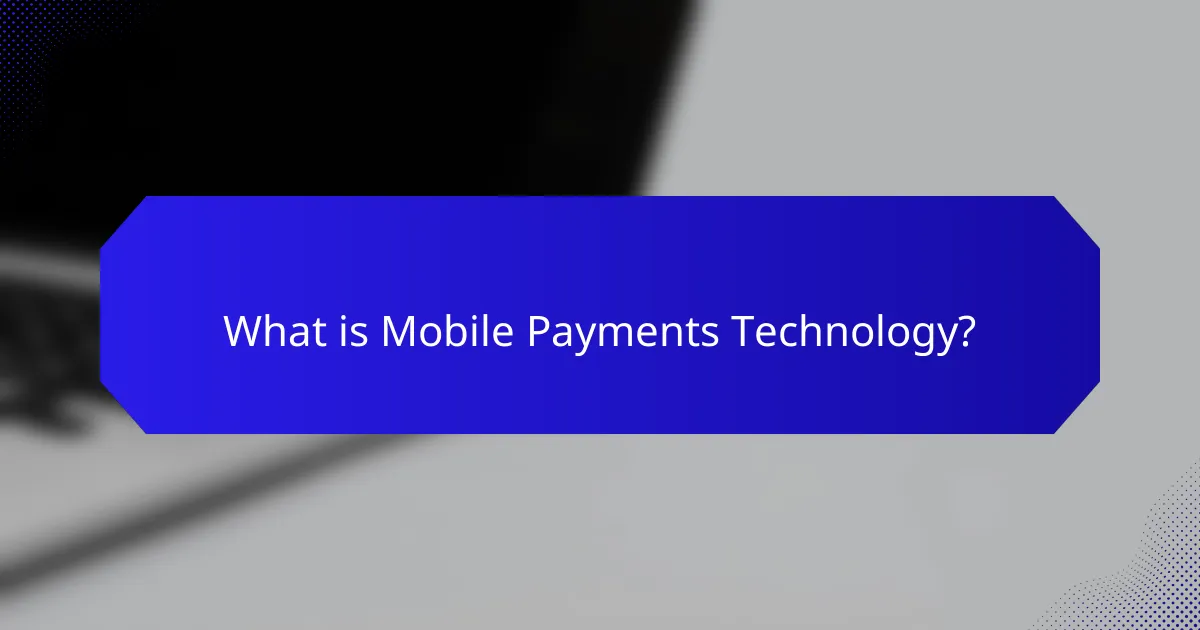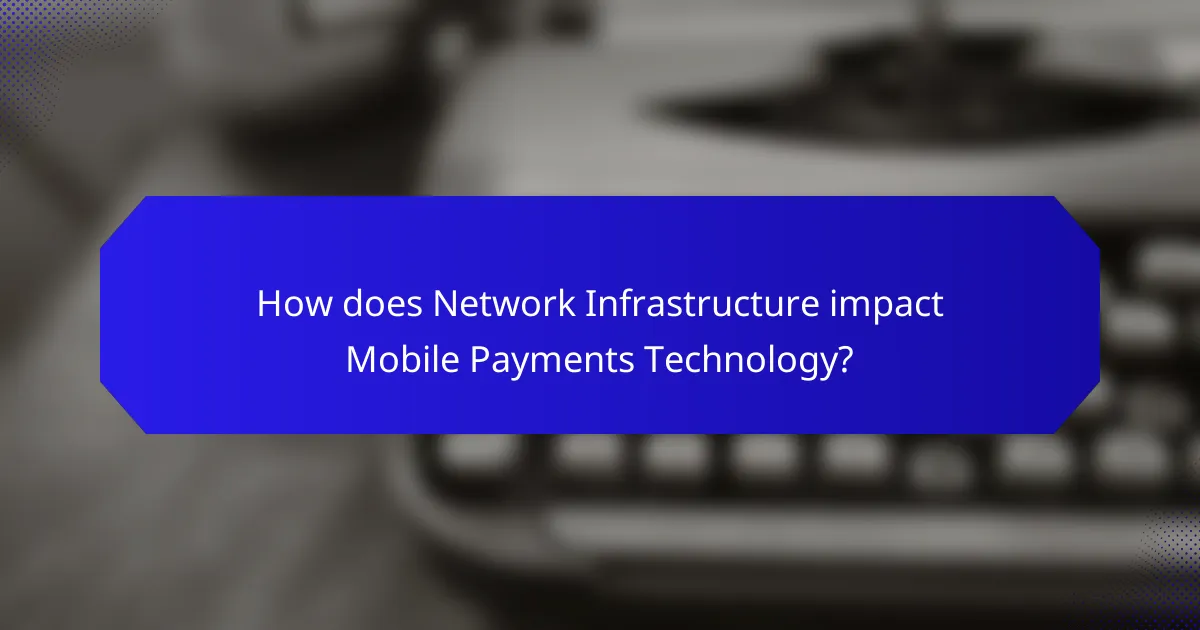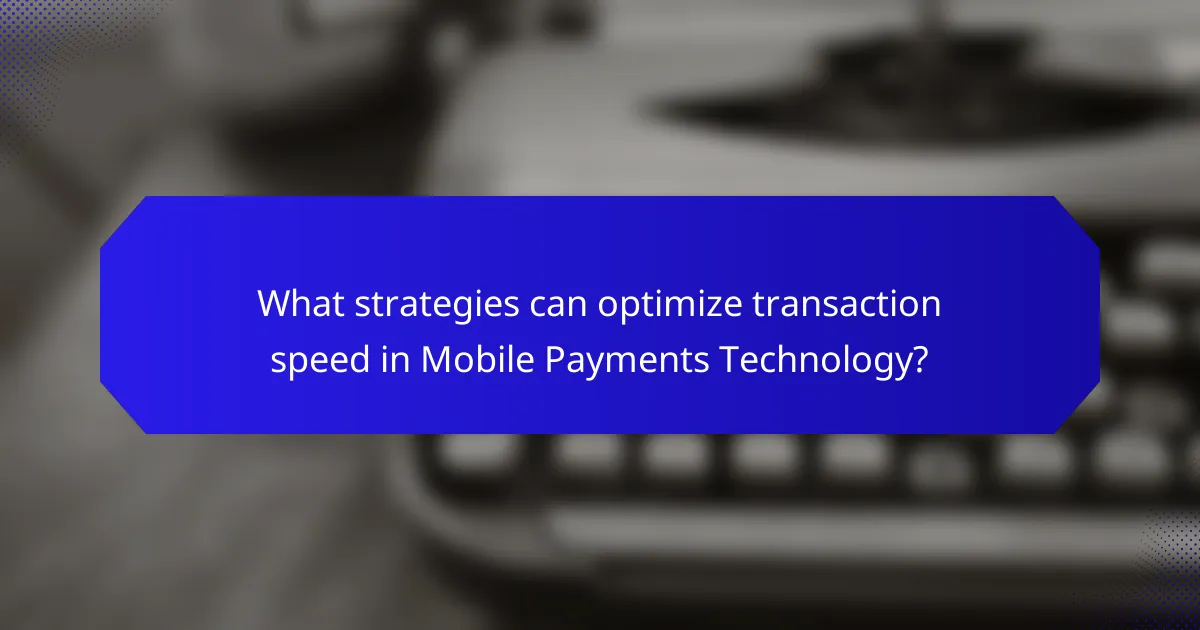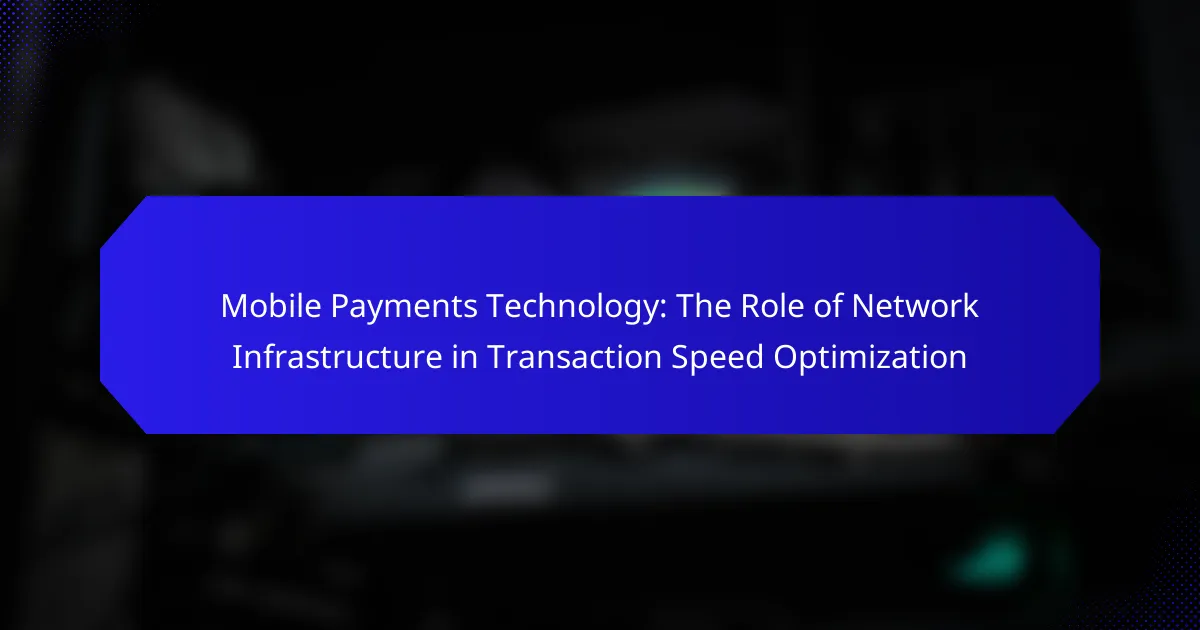Mobile payments technology enables financial transactions through mobile devices such as smartphones, tablets, and smartwatches, utilizing methods like mobile wallets, near field communication (NFC), and QR codes. The projected transaction value for mobile payments is expected to exceed $4.5 trillion by 2023, highlighting its growing significance in enhancing convenience and security for users. The article examines the critical role of network infrastructure in optimizing transaction speed, emphasizing that robust networks improve data transmission and reduce delays, which are crucial for user satisfaction. Additionally, it discusses strategies for real-time processing, including faster communication protocols, edge computing, and advanced encryption techniques, all aimed at enhancing the efficiency and user-friendliness of mobile payment systems.

What is Mobile Payments Technology?
Mobile payments technology refers to the use of mobile devices to conduct financial transactions. This includes payments made via smartphones, tablets, and smartwatches. Mobile payments can occur through various methods such as mobile wallets, near field communication (NFC), and QR codes. According to a report by Statista, mobile payment transaction value is projected to reach over $4.5 trillion by 2023. This technology enhances convenience by allowing users to make purchases without physical cash or cards. It also provides added security features, such as biometric authentication and encryption.
How does Mobile Payments Technology facilitate transactions?
Mobile payments technology facilitates transactions by enabling users to make payments using their mobile devices. This technology utilizes near-field communication (NFC), QR codes, or mobile apps to transmit payment information securely. Users can link their bank accounts or credit cards to mobile wallets for easy access. The process is usually quick, often taking only a few seconds to complete. Mobile payments enhance convenience by allowing transactions without physical cash or cards. Security features, such as encryption and tokenization, protect sensitive data during the transaction. According to a report by Statista, mobile payment transaction volume is projected to reach $12 trillion by 2025, indicating widespread adoption and trust in this technology.
What are the key components of Mobile Payments Technology?
The key components of Mobile Payments Technology include mobile devices, payment applications, secure payment gateways, and communication protocols. Mobile devices serve as the primary interface for users to initiate transactions. Payment applications facilitate the transaction process by securely storing payment information. Secure payment gateways ensure that transaction data is encrypted and processed safely. Communication protocols enable data transmission between the mobile device and payment systems. These components work together to provide a seamless and secure payment experience.
How do these components interact during a transaction?
During a mobile payment transaction, various components interact seamlessly to facilitate the transfer of funds. The primary components include the mobile device, payment application, network infrastructure, and payment processor.
The mobile device initiates the transaction by sending payment details through the payment application. The payment application encrypts this information for security. The encrypted data is then transmitted over the network infrastructure, which may include Wi-Fi or cellular networks.
Once the payment details reach the payment processor, it verifies the transaction by checking the user’s account balance and authentication. After verification, the payment processor communicates with the bank to authorize the transfer of funds.
The bank confirms the transaction and sends a response back through the payment processor. This information travels back through the network infrastructure to the mobile device, completing the transaction.
This interaction occurs within seconds, demonstrating the efficiency of mobile payment technology. The speed of this process is heavily influenced by the robustness of the network infrastructure, which minimizes latency and optimizes transaction speed.
What are the advantages of using Mobile Payments Technology?
Mobile payments technology offers numerous advantages, including convenience, speed, and enhanced security. Users can make transactions quickly using their smartphones, eliminating the need for cash or cards. This technology allows for seamless integration with various payment platforms, facilitating easy access to funds. According to a report by Statista, mobile payment transaction values are expected to reach over $12 trillion by 2025. Furthermore, mobile payments often employ advanced encryption methods, providing a secure way to conduct financial transactions. The ability to track spending through mobile apps also helps users manage their finances more effectively.
How does Mobile Payments Technology enhance user convenience?
Mobile Payments Technology enhances user convenience by enabling quick and seamless transactions. Users can make payments using their smartphones without the need for cash or physical cards. This technology supports contactless payments, allowing transactions to occur in seconds. Additionally, it provides users with easy access to their payment information and transaction history. Mobile payments often integrate with digital wallets, which store multiple payment methods securely. According to a report by Statista, mobile payment users are expected to reach 1.31 billion by 2023, indicating widespread adoption. This growth reflects the convenience and efficiency that mobile payments offer to consumers.
What security features are integrated into Mobile Payments Technology?
Mobile Payments Technology integrates several security features to protect transactions. These features include encryption, which secures data during transmission. Tokenization is another feature, replacing sensitive information with unique identifiers. Biometric authentication enhances security by requiring fingerprint or [censured] recognition. Two-factor authentication adds an extra layer by requiring additional verification methods. Secure elements store sensitive data in a tamper-resistant environment. Regular security updates ensure systems remain protected against vulnerabilities. According to a report by the Federal Reserve, these features significantly reduce fraud risk in mobile transactions.

How does Network Infrastructure impact Mobile Payments Technology?
Network infrastructure significantly impacts mobile payments technology by determining transaction speed and reliability. A robust network allows for faster data transmission, which is crucial for real-time payment processing. High bandwidth and low latency are essential for seamless transactions. Inadequate network infrastructure can lead to delays and failures in payment processing. Research indicates that 53% of users abandon transactions due to slow connections. Therefore, efficient network infrastructure directly enhances user experience and trust in mobile payment systems.
What role does network latency play in transaction speed?
Network latency significantly affects transaction speed by introducing delays in data transmission. High latency results in slower communication between devices and servers. This delay can lead to longer wait times for transaction confirmations. In mobile payments, where speed is crucial, even milliseconds of latency can impact user experience. Studies show that a reduction in latency can enhance transaction speed and overall efficiency. For example, a latency of 100 milliseconds can reduce transaction completion rates by up to 20%. Therefore, minimizing network latency is essential for optimizing transaction speed in mobile payment systems.
How can network latency be minimized in mobile payments?
Network latency in mobile payments can be minimized by optimizing data transmission protocols. Using faster communication protocols like HTTP/2 can significantly reduce latency. Implementing edge computing allows data processing closer to the user, which decreases the time taken for data to travel. Utilizing content delivery networks (CDNs) can also enhance speed by distributing data across multiple locations. Additionally, reducing the size of data packets through compression techniques can improve transmission speed. Regularly updating network infrastructure ensures compatibility with the latest technologies, further reducing latency. Statistics show that optimizing these factors can lead to a latency reduction of up to 50%.
What are the effects of latency on user experience?
Latency negatively impacts user experience by causing delays in response times. High latency can lead to frustration and dissatisfaction among users. Users expect instant feedback during mobile transactions. A delay of even a few seconds can result in abandoned transactions. Research indicates that a latency increase of 100 milliseconds can reduce user satisfaction by 20%. Furthermore, prolonged latency can deter users from returning to an application. In mobile payments, low latency is crucial for maintaining trust and efficiency. Therefore, optimizing network infrastructure to minimize latency is essential for enhancing user experience.
How does bandwidth influence transaction efficiency?
Bandwidth directly influences transaction efficiency by determining the amount of data that can be transmitted over a network in a given time. Higher bandwidth allows for faster data transfer rates, which reduces the time taken to process transactions. In mobile payments, this speed is critical for ensuring quick authorization and confirmation of payments. Studies indicate that transactions can be delayed by up to 30% in low-bandwidth scenarios. Conversely, increased bandwidth can enhance transaction success rates and customer satisfaction. For instance, a report by Cisco highlights that networks with higher bandwidth experience significantly lower latency, leading to smoother transaction flows.
What is the ideal bandwidth for optimal mobile payment transactions?
The ideal bandwidth for optimal mobile payment transactions is at least 1 Mbps. This bandwidth ensures quick data transmission during payment processing. Most mobile payment systems require minimal data for transaction completion. However, higher bandwidth can enhance user experience. For instance, 4G networks typically offer bandwidths of 10 Mbps or higher. This capacity allows for faster and more reliable transactions. According to research by Ericsson, mobile payment transactions are significantly faster on networks with higher bandwidth. Thus, a minimum of 1 Mbps is essential for efficient mobile payment processing.
How does insufficient bandwidth affect transaction success rates?
Insufficient bandwidth negatively impacts transaction success rates by causing delays and timeouts. When bandwidth is limited, data transfer rates slow down. This results in longer processing times for mobile payment transactions. Users may experience failed transactions due to timeouts. Research indicates that 53% of mobile users abandon transactions if they take longer than three seconds. Consequently, low bandwidth can lead to increased abandonment rates. A study by J.D. Power found that slow transaction speeds significantly decrease customer satisfaction. This further illustrates the critical role of sufficient bandwidth in ensuring successful mobile payments.

What strategies can optimize transaction speed in Mobile Payments Technology?
Implementing real-time processing systems can optimize transaction speed in mobile payments technology. Real-time processing reduces latency by enabling immediate transaction verification. Utilizing faster communication protocols, such as HTTP/2 or QUIC, enhances data transfer efficiency. Optimizing server response times through load balancing can also minimize delays. Employing edge computing can bring processing closer to users, reducing round-trip time. Integrating advanced encryption techniques ensures security without compromising speed. Additionally, leveraging artificial intelligence for fraud detection can streamline the approval process. These strategies collectively enhance transaction speed, making mobile payments more efficient and user-friendly.
How can businesses enhance their network infrastructure for mobile payments?
Businesses can enhance their network infrastructure for mobile payments by upgrading to high-speed internet connections. A reliable and fast network reduces transaction times significantly. Implementing robust security measures is also essential. This includes encryption protocols to protect sensitive data during transactions.
Investing in advanced routers and switches improves connectivity and reduces latency. Utilizing cloud-based services can offer scalability and flexibility for handling peak transaction loads. Regularly updating software and hardware keeps the infrastructure secure and efficient.
According to a report by the Federal Reserve, faster payment systems can lead to increased consumer satisfaction and trust. Enhanced infrastructure directly correlates with improved transaction speed and reliability, which are critical for mobile payments.
What technologies can be implemented to improve network performance?
Technologies that can be implemented to improve network performance include software-defined networking (SDN), network function virtualization (NFV), and 5G technology. SDN allows for centralized control of network resources, enhancing flexibility and efficiency. NFV enables the virtualization of network services, reducing dependency on hardware and improving scalability. 5G technology offers higher bandwidth and lower latency, significantly enhancing mobile transaction speeds. According to a study by the GSMA, 5G can provide speeds up to 10 Gbps, which is crucial for mobile payments. Additionally, implementing quality of service (QoS) mechanisms can prioritize critical traffic, ensuring smoother transaction processing.
How can businesses assess their current network infrastructure?
Businesses can assess their current network infrastructure by conducting a comprehensive network audit. This involves evaluating hardware, software, and network configurations. They should analyze bandwidth usage and identify bottlenecks. Monitoring tools can provide insights into network performance metrics. Security assessments are also crucial to identify vulnerabilities. Additionally, businesses should review compliance with industry standards. Gathering feedback from users can highlight areas needing improvement. Regular assessments help ensure the network supports mobile payment technologies effectively.
What best practices should be followed for effective mobile payment transactions?
Use secure payment methods for mobile transactions. This includes utilizing encryption and secure protocols like HTTPS. Implement two-factor authentication to enhance security. Regularly update mobile payment applications to protect against vulnerabilities. Educate users about phishing scams and fraudulent activities. Ensure a stable internet connection to minimize transaction failures. Optimize user interfaces for ease of use to reduce errors. Monitor transaction logs for unusual activity to detect fraud early.
How can users ensure secure and fast transactions on mobile payment platforms?
Users can ensure secure and fast transactions on mobile payment platforms by following specific practices. First, they should use strong, unique passwords and enable two-factor authentication. This adds an extra layer of security to their accounts. Second, users must keep their mobile apps and devices updated. Updates often include security patches that protect against vulnerabilities. Third, they should utilize secure Wi-Fi networks and avoid public Wi-Fi for transactions. Public networks can expose users to security risks. Fourth, users should monitor their transaction history regularly. This helps in identifying any unauthorized transactions quickly. According to a study by J.D. Power, 43% of users who monitor transactions feel more secure. Lastly, users should choose reputable mobile payment platforms known for robust security measures. These platforms often employ encryption and fraud detection technologies to protect users.
What common troubleshooting steps can improve transaction speed?
Common troubleshooting steps to improve transaction speed include optimizing network connections and ensuring sufficient bandwidth. A stable internet connection reduces latency and enhances transaction processing. Clearing cache and cookies can also speed up mobile applications. Regularly updating software ensures compatibility and performance improvements. Minimizing background applications frees up device resources for payment processing. Using a wired connection instead of Wi-Fi can enhance stability. Testing the payment system during off-peak hours can identify network congestion issues. Lastly, verifying server status can help determine if external factors are affecting transaction speed.
Mobile payments technology encompasses the use of mobile devices for financial transactions, utilizing methods such as mobile wallets, NFC, and QR codes. This article explores how mobile payments facilitate transactions through secure components like payment applications and gateways, emphasizing the impact of network infrastructure on transaction speed and efficiency. Key advantages of mobile payments include convenience, speed, and enhanced security features, while the article also addresses the importance of minimizing network latency and bandwidth for optimal transaction success. Additionally, it highlights best practices for users and businesses to ensure secure and efficient mobile payment experiences.
